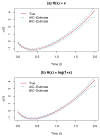Joint partially linear model for longitudinal data with informative drop-outs
- PMID: 27479944
- PMCID: PMC5525063
- DOI: 10.1111/biom.12566
Joint partially linear model for longitudinal data with informative drop-outs
Abstract
In biomedical research, a steep rise or decline in longitudinal biomarkers may indicate latent disease progression, which may subsequently cause patients to drop out of the study. Ignoring the informative drop-out can cause bias in estimation of the longitudinal model. In such cases, a full parametric specification may be insufficient to capture the complicated pattern of the longitudinal biomarkers. For these types of longitudinal data with the issue of informative drop-outs, we develop a joint partially linear model, with an aim to find the trajectory of the longitudinal biomarker. Specifically, an arbitrary function of time along with linear fixed and random covariate effects is proposed in the model for the biomarker, while a flexible semiparametric transformation model is used to describe the drop-out mechanism. Advantages of this semiparametric joint modeling approach are the following: 1) it provides an easier interpretation, compared to standard nonparametric regression models, and 2) it is a natural way to control for common (observable and unobservable) prognostic factors that may affect both the longitudinal trajectory and the drop-out process. We describe a sieve maximum likelihood estimation procedure using the EM algorithm, where the Akaike information criterion (AIC) and Bayesian information criterion (BIC) are considered to select the number of knots. We show that the proposed estimators achieve desirable asymptotic properties through empirical process theory. The proposed methods are evaluated by simulation studies and applied to prostate cancer data.
Keywords: Joint models; Longitudinal data; Nonparametric maximum likelihood; Partially linear model; Random effects; Sieve maximum likelihood; Transformation models.
© 2016, The International Biometric Society.
Figures



Similar articles
-
Classification of longitudinal data through a semiparametric mixed-effects model based on lasso-type estimators.Biometrics. 2015 Jun;71(2):333-43. doi: 10.1111/biom.12280. Epub 2015 Jan 30. Biometrics. 2015. PMID: 25639332
-
Estimation and comparison of rates of change in longitudinal studies with informative drop-outs.Stat Med. 1999 May 30;18(10):1215-33. doi: 10.1002/(sici)1097-0258(19990530)18:10<1215::aid-sim118>3.0.co;2-6. Stat Med. 1999. PMID: 10363341
-
Modeling longitudinal data with nonparametric multiplicative random effects jointly with survival data.Biometrics. 2008 Jun;64(2):546-56. doi: 10.1111/j.1541-0420.2007.00896.x. Epub 2007 Sep 20. Biometrics. 2008. PMID: 17888040 Free PMC article.
-
Model selection and psychological theory: a discussion of the differences between the Akaike information criterion (AIC) and the Bayesian information criterion (BIC).Psychol Methods. 2012 Jun;17(2):228-43. doi: 10.1037/a0027127. Epub 2012 Feb 6. Psychol Methods. 2012. PMID: 22309957 Free PMC article. Review.
-
Smoothing splines for longitudinal data.Stat Med. 1995 Jun 15;14(11):1235-48. doi: 10.1002/sim.4780141108. Stat Med. 1995. PMID: 7667563 Review.
Cited by
-
Joint models for dynamic prediction in localised prostate cancer: a literature review.BMC Med Res Methodol. 2022 Sep 19;22(1):245. doi: 10.1186/s12874-022-01709-3. BMC Med Res Methodol. 2022. PMID: 36123621 Free PMC article. Review.
-
A varying-coefficient generalized odds rate model with time-varying exposure: An application to fitness and cardiovascular disease mortality.Biometrics. 2019 Sep;75(3):853-863. doi: 10.1111/biom.13057. Epub 2019 Jun 17. Biometrics. 2019. PMID: 31132151 Free PMC article.
References
-
- Beunckens C, Molenberghs G, Verbeke G, Mallinckrodt C. A latent-class mixture model for incomplete longitudinal Gaussian data. Biometrics. 2008;64:96–105. - PubMed
-
- Dabrowska DM, Doksum KA. Partial likelihood in transformation models with censored data. Scandinavian Journal of Statistics. 1988;15:1–23.
-
- Geman S, Hwang CR. Nonparametric maximum likelihood estimation by the method of sieves. Annals of Statistics. 1982;10:401–414.
MeSH terms
Substances
Grants and funding
LinkOut - more resources
Full Text Sources
Other Literature Sources

